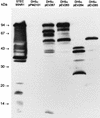Molecular analysis of Shiga toxigenic Escherichia coli O111:H- proteins which react with sera from patients with hemolytic-uremic syndrome
- PMID: 9529069
- PMCID: PMC108076
- DOI: 10.1128/IAI.66.4.1467-1472.1998
Molecular analysis of Shiga toxigenic Escherichia coli O111:H- proteins which react with sera from patients with hemolytic-uremic syndrome
Abstract
Western blot analysis was used to assess the reactivity of convalescent-phase sera from patients who were associated with an outbreak of hemolytic-uremic syndrome (HUS) caused by fermented sausage contaminated with Shiga toxin-producing Escherichia coli (STEC). The predominant STEC isolated from HUS patients belonged to serotype O111:H-, and reactivity to O111:H- whole-cell lysates, treated or untreated with proteinase K, was examined. As expected, all five serum samples demonstrated a marked anti-lipopolysaccharide response, but several protein bands were also immunoreactive, particularly one with an apparent size of 94 kDa. One convalescent-phase serum sample was subsequently used to screen an O111:H- cosmid bank and 2 of 900 cosmid clones were found to be positive, both of which contained a similar DNA insert. Western blot analysis of one of these clones identified three major immunoreactive protein bands of approximately 94, 70, and 50 kDa. An immune response to the three proteins was detectable with all five convalescent-phase serum samples but not with healthy human serum. Immunoreactive 94- and 50-kDa species were produced by a deletion derivative of the cosmid containing a 7-kb STEC DNA insert. Sequence analysis of this region indicated that it is part of the locus for enterocyte effacement, including the eaeA gene which encodes intimin. The deduced amino acid sequence of the O111:H- intimin was 88.6% identical to intimin from O157:H7 STEC, and the most divergent region was the 200 residues at the carboxyl terminus, which were only 75% identical. Such variation may be antigenically significant as serum from a HUS patient infected only with the O111:H- STEC reacted with intimin from an enteropathogenic E. coli O111 strain, as well as several other eaeA-positive STEC isolates, but not with an eaeA-positive STEC belonging to serotype O157:H-. Sera from two of the other HUS patients also failed to react with intimin from this latter strain. However, intimin from O157:H- STEC did react with serum from a patient infected with both O111:H- and O157:H- STEC.
Figures






Similar articles
-
Translocated intimin receptors (Tir) of Shiga-toxigenic Escherichia coli isolates belonging to serogroups O26, O111, and O157 react with sera from patients with hemolytic-uremic syndrome and exhibit marked sequence heterogeneity.Infect Immun. 1998 Nov;66(11):5580-6. doi: 10.1128/IAI.66.11.5580-5586.1998. Infect Immun. 1998. PMID: 9784578 Free PMC article.
-
Molecular microbiological investigation of an outbreak of hemolytic-uremic syndrome caused by dry fermented sausage contaminated with Shiga-like toxin-producing Escherichia coli.J Clin Microbiol. 1996 Jul;34(7):1622-7. doi: 10.1128/JCM.34.7.1622-1627.1996. J Clin Microbiol. 1996. PMID: 8784557 Free PMC article.
-
Antibody response to lipopolysaccharides and recombinant proteins of Shiga toxin (STX)-producing Escherichia coli (STEC) in children with haemolytic uraemic syndrome in Poland.Lett Appl Microbiol. 2020 Jun;70(6):440-446. doi: 10.1111/lam.13295. Epub 2020 Apr 28. Lett Appl Microbiol. 2020. PMID: 32270510
-
Detection and characterization of Shiga toxigenic Escherichia coli by using multiplex PCR assays for stx1, stx2, eaeA, enterohemorrhagic E. coli hlyA, rfbO111, and rfbO157.J Clin Microbiol. 1998 Feb;36(2):598-602. doi: 10.1128/JCM.36.2.598-602.1998. J Clin Microbiol. 1998. PMID: 9466788 Free PMC article.
-
Enterohemolytic phenotypes and genotypes of shiga toxin-producing Escherichia coli O111 strains from patients with diarrhea and hemolytic-uremic syndrome.J Clin Microbiol. 1996 Oct;34(10):2364-7. doi: 10.1128/jcm.34.10.2364-2367.1996. J Clin Microbiol. 1996. PMID: 8880480 Free PMC article.
Cited by
-
Typing of intimin genes in human and animal enterohemorrhagic and enteropathogenic Escherichia coli: characterization of a new intimin variant.Infect Immun. 2000 Jan;68(1):64-71. doi: 10.1128/IAI.68.1.64-71.2000. Infect Immun. 2000. PMID: 10603369 Free PMC article.
-
Up-regulation of both intimin and eae-independent adherence of shiga toxigenic Escherichia coli O157 by ler and phenotypic impact of a naturally occurring ler mutation.Infect Immun. 2000 Sep;68(9):5344-53. doi: 10.1128/IAI.68.9.5344-5353.2000. Infect Immun. 2000. PMID: 10948164 Free PMC article.
-
Molecular evolution of the intimin gene in O111 clones of pathogenic Escherichia coli.J Bacteriol. 2002 Jan;184(2):479-87. doi: 10.1128/JB.184.2.479-487.2002. J Bacteriol. 2002. PMID: 11751825 Free PMC article.
-
Treatment and outcome of Shiga-toxin-associated hemolytic uremic syndrome (HUS).Pediatr Nephrol. 2008 Oct;23(10):1749-60. doi: 10.1007/s00467-008-0935-6. Epub 2008 Aug 13. Pediatr Nephrol. 2008. PMID: 18704506 Free PMC article. Review.
-
Decreased adherence of enterohemorrhagic Escherichia coli to HEp-2 cells in the presence of antibodies that recognize the C-terminal region of intimin.Infect Immun. 1999 Dec;67(12):6409-17. doi: 10.1128/IAI.67.12.6409-6417.1999. Infect Immun. 1999. PMID: 10569757 Free PMC article.
References
-
- Altschul S F, Gish W, Miller W, Myers E W, Lipman D J. Basic local alignment search tool. J Mol Biol. 1990;215:403–410. - PubMed
-
- Barrett T J, Kaper J B, Jerse A E, Wachsmuth I K. Virulence factors in Shiga-like toxin-producing Escherichia coli isolated from humans and cattle. J Infect Dis. 1992;165:979–980. - PubMed
-
- Beebakhee G, Louie M, De Azavedo J, Brunton J. Cloning and nucleotide sequence of the eae gene homologue from enterohemorrhagic Escherichia coli serotype O157:H7. FEMS Microbiol Lett. 1992;91:63–68. - PubMed
-
- Donnenberg M S, Kaper J B, Finlay B B. Interactions between enteropathogenic Escherichia coli and host epithelial cells. Trends Microbiol. 1997;5:109–114. - PubMed
Publication types
MeSH terms
Substances
Associated data
- Actions
LinkOut - more resources
Full Text Sources
Research Materials

